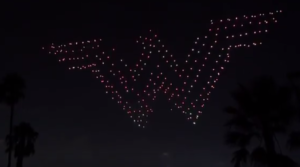
Intel was reportedly testing the show and invited employees and families to watch. The show utilized 500 drones, which launched into the sky and performed a choreographed routine.
The show, described by onlookers as “breathtaking,” and “the coolest thing ever,” has been featured at the SuperBowl, Wonder Woman launch, and will be seen at the 2018 Winter Olympics. But as GM of Intel’s Drone Group Anil Nanduri tells DRONELIFE, the light show isn’t all about making pretty pictures in the sky.
The Shooting Star drones are tiny – almost cute – and completely non-threatening. The blades are entirely enclosed in a wire cage. They are lightweight and safety is inherent in their design.
But while these tiny drones are used purely for entertainment, they are a powerful way of testing new drone technology that could allow fleets of drones powered from a central point to perform commercial operations. The light shows have allowed Intel’s engineers to address questions of redundancy, safety, and precision. What happens if one of the 500 fails? How does a replacement drone know to join the design? How complex can your choreography get?
While Intel is diving deeply into technology with significant future potential for the commercial drone industry, the public is geting enthused about the idea of drones in the sky. Drone light shows are an excellent way of reaching a large number of people, in a non-controversial way, and showing them a small part of what drones can do.
“Light shows started as just a cool ‘Put a logo in the sky’ for us, but now people all over the world want to see them,” says Nanduri. “You can see how the creation of new technology brings a demand – in some cases, you have to build it and take on the burden of proving it.”
Miriam McNabb is the Editor-in-Chief of DRONELIFE and CEO of JobForDrones, a professional drone services marketplace, and a fascinated observer of the emerging drone industry and the regulatory environment for drones. Miriam has penned over 3,000 articles focused on the commercial drone space and is an international speaker and recognized figure in the industry. Miriam has a degree from the University of Chicago and over 20 years of experience in high tech sales and marketing for new technologies.
For drone industry consulting or writing, Email Miriam.
TWITTER:@spaldingbarker
Subscribe to DroneLife here.